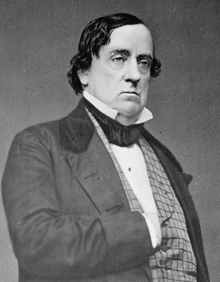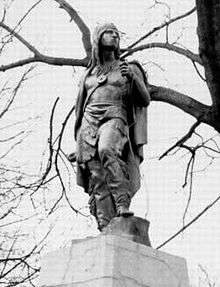Treaty of Greenville (1814)
The Treaty of Greenville (1814) was called A treaty of peace and friendship between the United States of America and the tribes of Native Americans called the Wyandots, Delawares, Shawanoese, Senacas and Miamies. It was concluded at Greenville, Ohio on July 22, 1814, to provide peace among the tribes, and with the U.S., as well as an alliance between these Tribes and the U.S. against Great Britain during the War of 1812. It followed the earlier Treaty of Greenville in 1795, which had ended the Northwest Indian Wars, and allowed peaceful American expansion and trade into the Northwest Territory.
Summary of Treaty
Article I establishes peace between the Miami, Potawatomi, Ottawa, and Kickapoo with the U.S., Wyandot, Delaware, Shawnee, and Seneca. Article II calls for the tribes to give aid to the U.S. in their war against Great Britain and her Native American allies, and not to make an independent peace. Article III has the tribes acknowledge themselves under the protection of the U.S., and no other power. In Article IV, the U.S. promises to respect their boundaries with the Native American Nations, established before the war, if the other conditions of the treaty are performed.
Text of Treaty[1]
Preamble
The said United States of America, by William Henry Harrison, late a major general in the army of the United States, and Lewis Cass, governor of the Michigan Territory, duly authorised and appointed commissioners for the purpose, and the said tribes, by their head men, chiefs, and warriors, assembled at Greenville, in the state of Ohio, have agreed to the following articles, which, when ratified by the president of the United States, by and with the consent of the Senate thereof, shall be binding upon them and the said tribes.
Article I
The United States and the Wyandots, Delawares, Shawanoese, and Senacas, give peace to the Miamie nation of Native Americans, formerly designated as the Miamie Eel River and Weea tribes; they extend this indulgence also to the bands of the Putawatimies, which adhere to the Grand Sachem Tobinipee, and to the chief Onoxa, to the Ottawas of Blanchard’s creek, who have attached themselves to the Shawanoese tribe, and to such of the said tribe as adhere to the chief called the Wing, in the neighborhood of Detroit, and to the Kickapoos, under the direction of their chiefs who sign this treaty.
Article II
The tribes and bands abovementioned, engage to give their aid to the United States in prosecuting the war against Great-Britain, and such of the Native American tribes as still continue hostile; and to make no peace with either without the consent of the United States. The assistance herein stipulated for, is to consist of such number of their warriors from each tribe, as the president of the United States, or any officer having his authority therefor, may require.

Article III
The Wyandot tribe, and the Senecas of Sandusky and Stony Creek, the Delaware and Shawanoese tribes, who have preserved their fidelity to the United States throughout the war, again acknowledge themselves under the protection of the said states, and no other power whatever; and agree to aid the United States, in the manner stipulated in the former article, and to make no peace but with the consent of the said states.
Article IV
In the event of the faithful performance of the conditions of this treaty, the United States will confirm and establish all the boundaries between their lands and those of the Wyandots, Delawares, Shawanoese, and Miamies, as they existed previously to the commencement of the war.
IN TESTIMONY WHEREOF, the said commissioners and the said head men, chiefs, and warriors, of the beforementioned tribes of Native Americans, have hereunto set their hands and affixed their seals.
Done at Greenville, in the State of Ohio, this twenty-second day of July, in the year of our Lord one thousand eight hundred and fourteen, and of the Independence of the United States, the thirty-ninth.
- WILLIAM HENRY HARRISON,
- LEWIS CASS
Wyandots

- Tar-he, or crane
- Har-rone-yough, or Cherokee boy
- Te-ar-ront-ou-ose, or between the logs
- Men-ou-cou
- Rush-ar-ra, or Stookey
- Se-no-shus
- Zash-u-on-a, or big arm
- Te-an-dut-to-sooh, or punch
- Tah-uh-sough, or John Hicks
- Ron-oin-ness, or sky come down
- Tee-en-do
- Ron-ai-is
- Omaint-si-ar-rah, or Bowyer
- Tai-un-shrah, or Charles
- Ti-un-dra-ha, or John Bolisle
- E-lone-ni-rah, or shrone-she
Delawares

- Kick-to-he-nina, or Capt. Anderson
- Le-mot-te-nuck-ques, or James Nantioke
- La-o-pon-nichle, or Bauber
- Jo-on-queake, or John Queake
- Kill-buck
- Neach-corningd
- Montgomery Montaine
- Captain Buck
- Hop-hoo-que, or moles
- Captain White Eyes
- Captain Pipe
- McDaniel
- Captain Snap
Shawanoese
- Cut-e-we-cus-a, or black hoof
- Tam-e-ne-tha, or butter
- Pi-a-se-ka, or wolf
- Pom-tha, or walker
- Sha-mon-e-tho, or snake
- Pem-tha-ta, or turkey flying by
- We-tha-wak-a-sik-a, or yellow water
- Que-ta-wah, or sinking
- So-kut-che-mah, or frozen
- Wy-ne-pu-ech-sika, or corn stalk
- Chi-ach-ska, or captain Tom
- Qui-ta-we-peh, or captain Lewis
- Tea-was-koota, or blue jacket
- Tah-cum-tequah, or cross the water
Ottawas
- Wa-tash-ne-wa, or bear’s legs
- Wa-pa-chek, or white fisher
- Too-ta-gen, or bell
- Augh-qua-nah-quo-se, or stump tail bear
- U-co-ke-nuh, or bear king
Senecas
- Coon-tind-nau, or coffee house
- Tog-won
- En-dosque-e-runt, or John Harris
- Can-ta-ra-tee-roo
- Cun-tah-ten-tuh-wa, or big turtle
- Ron-on-nesse, or wiping stick
- Co-rach-coon-ke, or reflection, or civil John
- Coon-au-ta-nah-coo
- See-is-ta-he, (black)
- Too-tee-an-dee, or Thomas Brand
- Hane-use-wa
- Ut-ta-wun-tus
- Lut-au-ques-on
Miamies
- Peoon
- La-passiere, or Ashe-non-quah
- Osage
- Na-to-wee-sa
- Me-she-ke-le-a-ta, or the big man
- Sa-na-mah-hon-ga, or stone eater
- Ne-she-peh-ta, or double tooth
- Me-too-sa-ni-a, or Indian
- Che-qui-a, or poor racoon
- Wa-pe-pe-cheka
- Chin-go-me-ga-eboe, or owl
- Ke-we-se-kong, or circular travelling
- Wa-pa-sa-ba-nah, or white racoon
- Che-ke-me-li-ne, or turtle’s brother
- Pocon-do-qua, or crooked
- Che-que-ah, or poor racoon, a Wea, or little eyes
- Sho-wi-lin-ge-shua, or open hand
- O-ka-we-a, or porcupine
- Shaw-wa-noe
- Ma-uan-sa, or young wolf
- Me-shwa-wa, or wounded
- San-gwe-comya, or buffaloe
- Pe-qui-a, or George
- Keel-swa, or sun
- Wab-se-a, or white skin
- Wan-se-pe-a, or sun rise
- An-ga-to-ka, or pile of wood
Potawatamies
- Too-pin-ne-pe
- O-nox-a, or five medals
- Me-te-a
- Con-ge, or bear’s foot
- Na-nown-se-ca
- Cha-gobbe, or one who sees all over
- Meshon
- Penosh
- Che-ca-noe
- Nesh-coot-a-wa
- Ton-guish
- Ne-baugh-qua
- Ton-guish, a Chippeway
- Wes-nan-e-sa
- Che-chock, or crane
- Ke-poo-ta
- Mac-kor-ta, or crow
- Pu-pe-ketcha, or flat belly
Kickapoos
- Kee-too-te, or otter
- Ma-ko-ta-ne-cote, or black tree
- She-she-pa, or duck
- Wa-pe-kon-nia, or white blanket
- A-coo-che, or the man hung
- Che-kas-ka-ga-lon
In the presence of (the words “and the Wyandots, Delawares, Shawanoese, and Senecas,” interlined in the first article before signing.) James Dill, Secretary of the commissioners. Jno. Johnson, Native American Agent. B.F. Stickney, Native American Agent. James J. Nisbet, Associate Justice of the Court of Common Pleas, Preble county. Thos. G. Gibson, Antoine Boindi, William Walker, William Conner, J. Bte. Chandonnai, Stephen Reeddeed, James Peltier, Joseph Bertrand, Sworn Interpreters. Thomas Ramsey, captain 1st rifle regiment. John Conner. John Riddle, col. 1st regiment Ohio militia.
To the Native American names are subjoined a mark and seal.
See also
References
- ↑ 7 Stat. 118 - Text of Treaty of Greenville (1814) Library of Congress